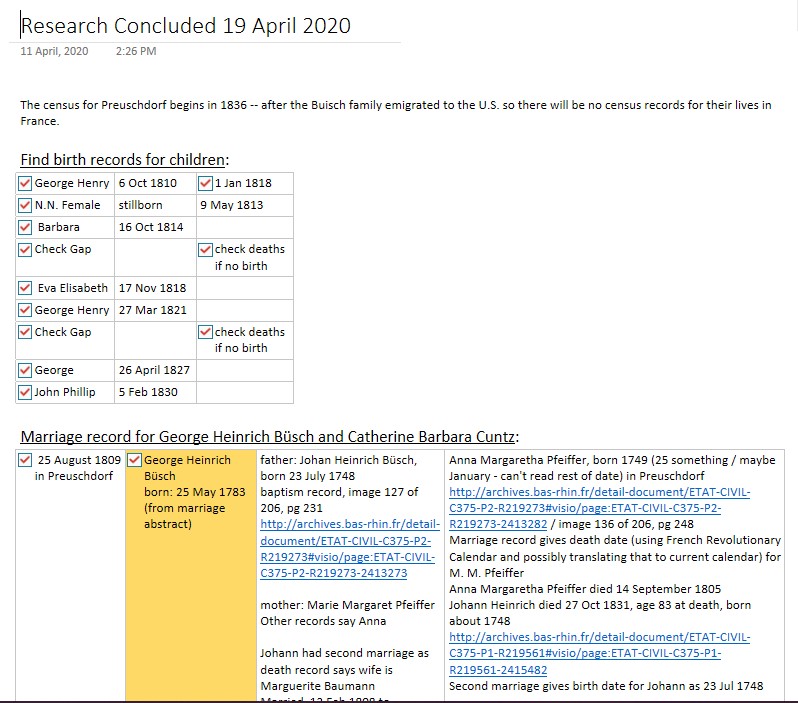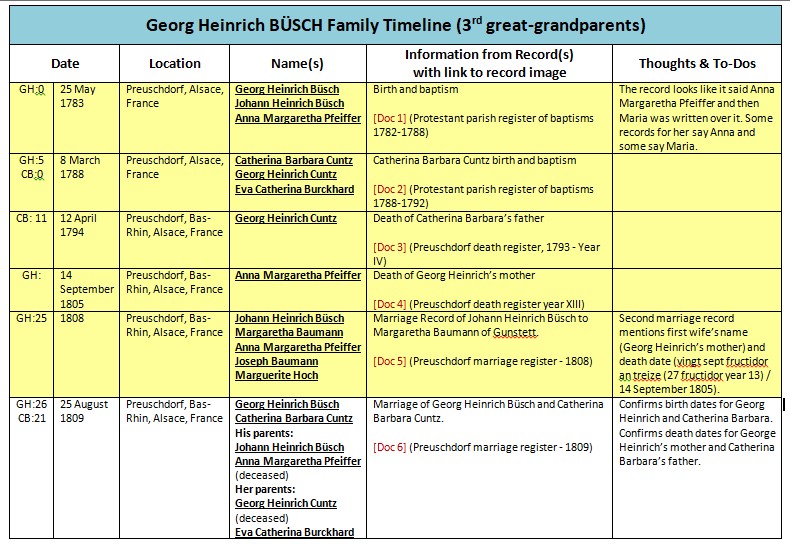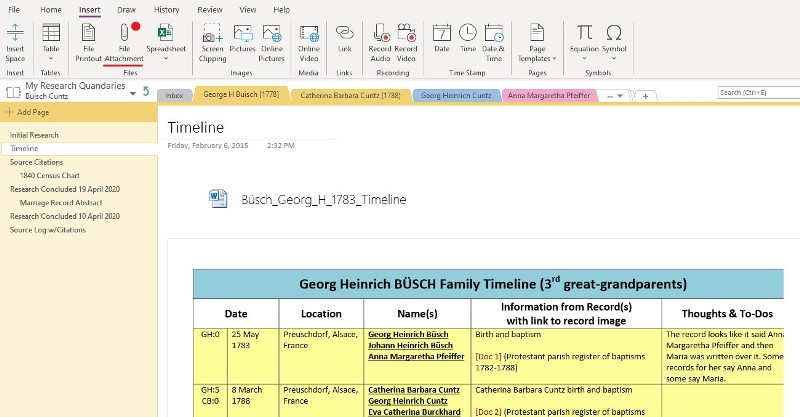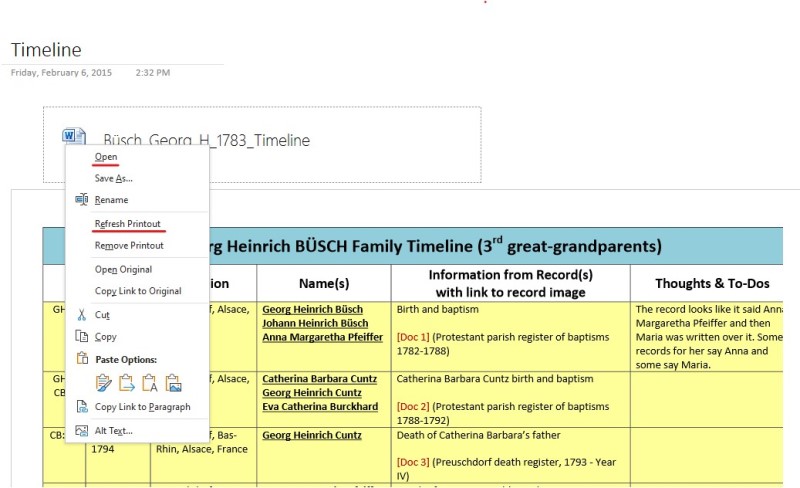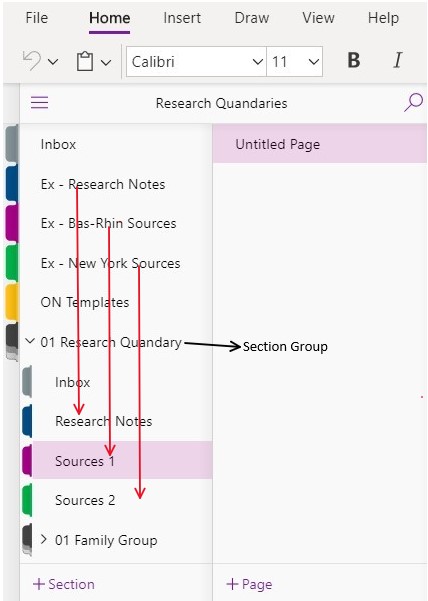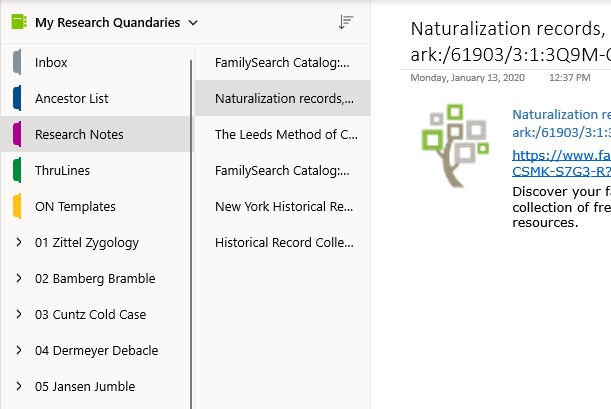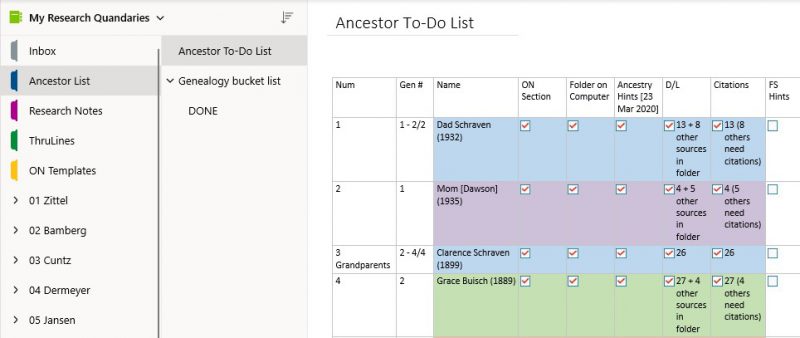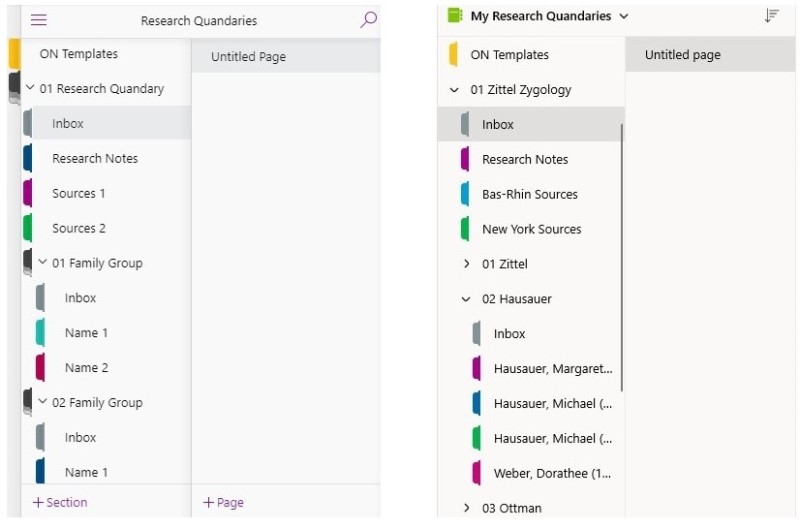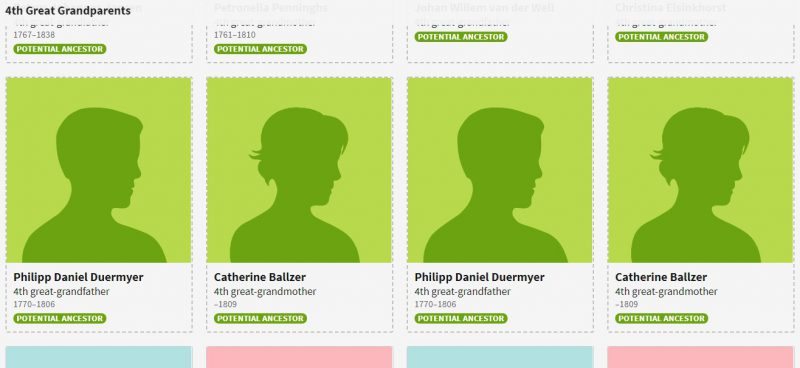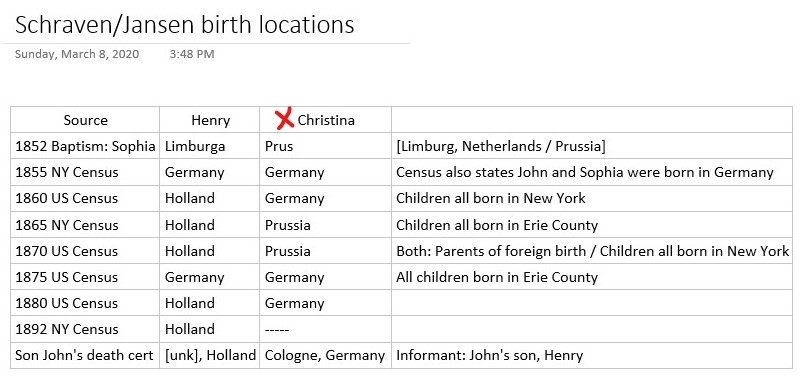[Disclaimer: There is no candlestick maker involved in this story. It just sounded good.] I found out that I come from a long line of bakers in Preuschdorf, France. (Four generations!) And just an FYI, the baker’s daughter married the butcher in Buffalo.
This post is actually about the Timeline Template I created in OneNote that I never use. Why don’t I use it? Mostly because I don’t like the tables in OneNote. I don’t like that I am unable to merge and split cells. I especially do not like how thin and light the lines are around the cells. (I have old eyeballs. Give me black lines around the cells, please.) I make my Timelines in MSWord and attach the file and a printout to the person’s Timeline page. I set the page orientation in Word to Landscape so I have more space across the page for all my columns. I have written about using timelines before. I will link to Anne Mitchell’s video again about how and why to create timelines at the bottom of this post if you want to view it later. The problem with the previous timeline example is the person in the example is not my real paternal grandfather. (I like to refer to him as my faux grandfather.) Yes, that whole DNA tree implosion thing I hinted about before. That timeline annoys me since it is a reminder of how much time I spent researching the wrong surname.
I have a new Timeline example though. I went back to my Büsch / Cuntz line and created a Timeline from the records that I have gathered during my research over the last couple months. I posted about initial research I conducted and concluded on this line a few weeks ago and the next round of research I was going to conduct. I finished that research and then created a Family Timeline in Word for this couple.
I had decided (Once again! Since I have made this decision before…) a while back that I wanted to tackle one of my direct-line ancestral couples per week — getting all their sources gathered, downloaded, cited and uploaded to Ancestry and WikiTree. (Since I’m fairly certain I don’t have 25 more years left to spend on research, this is important to me.) While working on this couple, I realized that while a week might be long enough for a couple that has less than 10 records or a couple that much of the research is already done, it may not be enough for other couples in my lines that need more research. For Georg Heinrich Büsch and Catherina Barbara Cuntz, I now have 28 records, 16 that are in French; so a week was not going to be long enough to finish up everything I wanted to accomplish. I haven’t even looked at land and probate records yet, nor completed my searches in the Buffalo City Directories. (Which will be the plan for the next time I visit this couple. Hopefully the records aren’t going anywhere in the meantime.) The new plan is to work on one ancestral couple for as long as it takes to find the usual records I might not already have in my tree — birth, marriage, death and census — while not get totally sidetracked — and then move on to the next couple. I had a similar plan years ago but got lost in caregiver duties and never had enough time for research. (Regarding only spending a week on each couple… That also doesn’t take into account the time I need to spend on ongoing research on the dilemmas in my Research Quandaries notebook because continuing research on those has to continue as well. Then there is all the quilting and fiber art related projects. Let’s not forget the Rosetta Stone French lessons either. I almost forgot about the gardening on the patio! Who needs Netflix? I could hold an online class on how to stay busy at home during a pandemic.)
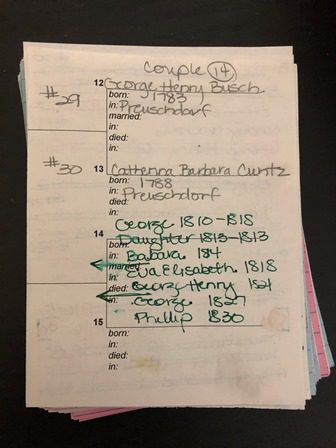
I had 50 couples with just some basic info on a scrap piece of paper to start. (There are 0 couples for my mother’s paternal line so the number would be higher if I knew my mother’s paternity.) Of course, I got sidetracked on the Büsch / Cuntz line. It’s inevitable. I did manage to not fall too far down the rabbit hole and to rein myself back in. Although I ended up going back two more generations, (Because rooting around in church records from the 1700s seemed like a fun challenge!) I didn’t get carried away researching all the children for the new couples and then on down each of those lines. (You know I was tempted!) I found a few records for the new generations which then added three more couples to my pile and then went back to my original couple like a good little researcher. (In real life, I am in introvert and do not talk this much. Really. Truly.)
When I left off with this couple, I was going to go back through birth and death records searching for more children. I also looked for the death records for the deceased parents mentioned in the marriage record. The parents still living at the time of the marriage both died before Henry and Barbara emigrated so I added them to the timeline as well. Because the death records mention their parents names, I got started down the rabbit hole. (Who doesn’t want to go a few generations farther back when the names are right there?) When I was digging further into these lines, I just made some notes in the table I had created for Henry and Barbara’s marriage record. I have copied that table over to the Sections for both fathers on their Initial Research pages and made notes about the next generation back. The second Initial Research for Georg Heinrich Büsch page looked like this when I finished:
=====
The first page of the Georg Heinrich Büsch Family Timeline in Word looks like this:
The citations for all the records I found are listed below the table. Here is a link to the PDF so you can view the whole thing.
=====
Once the Timeline is done, it can be attached to the Timeline page in the Person’s Section under > Insert > choose File Attachment > Insert Printout. A Word file icon appears at the top of the page and your Word pages are added as screenshots to the page.
You cannot edit the Word pages in OneNote. You must reopen the file in Word. To reopen the Timeline from OneNote, right click on the File Icon > choose Open. If you have made any changes to the Timeline in Word, you can refresh the printout (screenshots) in OneNote by right clicking on the file icon > choose Refresh Printout. (See below.)
=====
Georg Heinrich’s Section and all the other Sections I created for new family members as I needed them are now all neatly tucked back into the Buisch Surname Notebook where they belong. Note that Georg Heinrich’s new Initial Research page has a list of the next three items to research.
=====
I have added the sources to WikiTree.com for Georg Heinrich Büsch and Catherina Barbara Cuntz and I will be adding the citations and sources to Ancestry over the next few days and then it’s on to the next couple in the pile. I am not looking forward to doing the citations on Ancestry. I have contemplated uploading the Timeline PDF and calling it good but I won’t. The Cuntz Cold Case Sub-Section of my Research Quandaries notebook is officially closed. I’m doing a genealogy happy dance. (In my head. Because: Introvert.) Oh, and in case you are wondering, the baker’s daughter, Eva Elisabeth Büsch, married the butcher, Wilhelm Friedrich Beidinger/Baitinger on 26 June 1845 in Buffalo, Erie, New York.1
Until next time,
~Erin
1 “New York, Church Records, 1660-1954,” database, FamilySearch (https://familysearch.org/ark:/61903/1:1:QPZJ-SYVS : 10 October 2019), Wilhelm Friedrick Baidinger and Elisabeth Büsch, 26 Jun 1845; citing multiple churches, Marriage, Erie, New York, United States.
Creating Timelines: A 15 minute tutorial by Anne Mitchell (AKA: Ancestry Anne)
Cite This Page:
Erin Williamson Klein, “The Butcher, Baker and Candlestick Maker.” My Family History Files, 22 May 2020, (https://myfamilyhistoryfiles.com/onenote/the-butcher-baker-and-candlestick-maker/ : [access date]).
Please do not copy without attribution and link back to this page.
